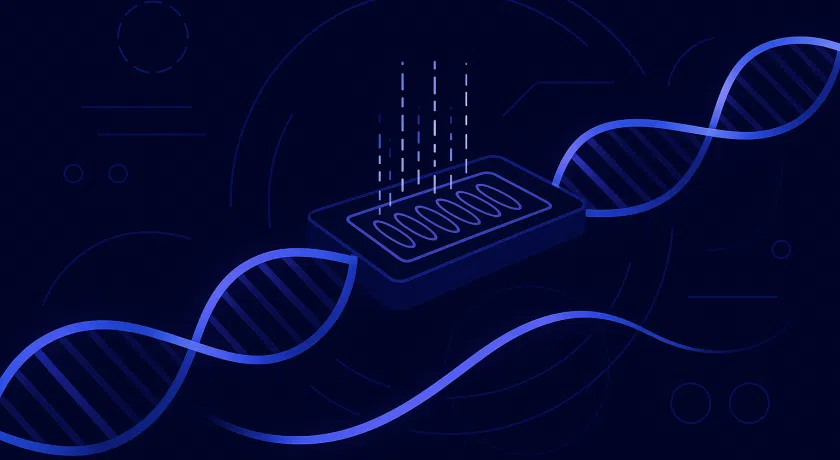
Heritable gene defects can cause the heart muscles to thicken and bring on hypertrophic cardiomyopathy. How this occurs is not entirely clear. This blog describes how single-cell RNA sequencing helps understand the hypertrophic heart and provide directions for future genetic research.
Hypertrophic cardiomyopathy is a heritable condition in which the heart thickens. It occurs in one in every two to five hundred people. And while most remain asymptomatic and live their life without complications, a small group of people can get life-threatening arrhythmia and risk a sudden death.
Unfortunately, the picture of the genetic causes of hypertrophic cardiomyopathy isn’t complete.
On one hand, research has firmly established a link to heritable defects in the heart muscles’ sarcomeres. Sarcomeres are the muscle’s basic contraction units (see image below). It’s known that genetic variants of sarcomere genes are involved in over half of the cases.
On the other hand, no genetic cause can be pointed out in about 40% of patients. Within one patient, the heart muscle cells (cardiomyocytes) also vary in how severely they swell up and disrupt heart function. This heterogeneous appearance of hypertrophy is not well understood.
A lack of knowledge about the mechanisms behind hypertrophic cardiomyopathy hinders the development of promising treatments. A group of scientists has used single-cell RNA sequencing to make an important step.

Hypertrophic cardiomyocytes at single-cell resolution
It makes sense to utilize single-cell RNA sequencing to try and resolve that incomplete picture. As we said earlier, hypertrophic cardiomyopathy is not a simple homogeneous disease. Studying the gene expression differences between cells could thus reveal important disease features. For example, it could point toward undiscovered causal genes with distorted expression in a small subgroup of hypertrophic cardiomyocytes.
So, what does the gene expression profile of hypertrophic cardiomyocytes look like at single-cell resolution? In this study by Martijn Wehrens et al., researchers from the Hubrecht Institute, UMC Utrecht, Amsterdam UMC, and Erasmus MC sequenced the mRNA of single cardiomyocytes from patients with hypertrophic cardiomyopathy. They could reveal an in-depth gene expression profile that showed great complexity.
SORT-seq works best for cardiomyocytes
Wehrens et al. employed the single-cell sequencing platform SORT-seq, which is currently the better choice for single-cell sequencing cardiomyocytes.
SORT-seq uses 384-well cell-capture plates and flow cytometry (FACS) sorting. In contrast to droplet-based RNA sequencing technologies like 10x Genomics, it also works for larger cells such as cardiomyocytes. 10x Genomics Chromium can capture cells up to 50 µm (source), so the ~ 125 µm cardiomyocytes pose a challenge. You can circumvent this challenge by performing single nuclei sequencing of cardiomyocytes. But with SORT-seq, you can also include all mature mRNA molecules from outside the nucleus.
So SORT-seq can create a comprehensive picture and works for cells of all sizes as long as a FACS protocol is available.

The researchers used a FACS protocol plus sequencing approach that was optimized at the Hubrecht Institute some years prior. You can read about it here. This protocol gave them the opportunity to preserve the size data of single cardiomyocytes—a valuable factor in understanding hypertrophy. More about this later.
Functional links between genes and regulatory networks
The team saw clear differences in gene expression when they compared healthy and hypertrophic heart samples. Well-known marker genes for cardiac stress made up part of that difference, but the data also revealed new genes that might be disease-related.
More connections were revealed after in-depth analysis. Wehrens et al. identified six different cardiomyocyte subpopulations in the hypertrophic heart. One of these showed high NPPA expression, a known cardiac stress marker. The researchers could pinpoint sets of co-expressed genes by looking for correlations in the data between genes that were differentially expressed together in specific cells. It’s a clever technique that takes advantage of the high amount of interconnected features in a single-cell RNA sequencing dataset. The researchers found more than one hundred well-known and new genes that showed co-expression with NPPA in this subpopulation. That’s a stepping stone for future research on how these genes and their interactions relate to cardiomyocyte stress.

Another possibly disease-relevant find involves XIRP2. This protein is known to interact with the cytoskeleton in heart muscles but isn’t well understood. Single-cell RNA sequencing showed that multiple subpopulations expressed XIRP2 in a gradient. It showed co-expression with a set of genes that a small group of transcription factors appear to regulate. These include NFE2L1, MAFK, FOXN3, and ZEB1. The data suggest that these gene regulatory networks play a role in hypertrophy, although how this works requires more research. Again, the single-cell data provides directions for further studies.
Functional links between genes and cell size
Finally, the group integrated their in-depth single-cell data with FACS data on cardiomyocyte size. It allowed them to look specifically at gene expression of larger, hypertrophic cells present in the thickened heart regions. They could link cell size to a group of co-expressed genes that include genes for myosin (MYL2 and MYL3). Myosin is the motor protein involved in muscle contraction (see the image of the sarcomere). Hence, they could identify cell size–related genes—yet another useful data source for future analysis.
The researchers revealed gene interactions by finding out their differentiated expression correlated between cells. In other words, they saw for which genes the expression levels differ between cells in the same way.
Doing this for disease-related genes unearths the entire molecular network involved. That’s made possible by the resolution and dataset size of single-cell RNA sequencing. The paper concludes that single-cell gene expression profiling has laid the groundwork for further research on the molecular mechanism behind hereditary hypertrophic cardiomyopathy. It reads: “Our study identifies many correlations, co-expression patterns, regulatory factors, and relations to cell size that offer an insight into this complex world.”
You can find the full paper below. Rather watch a movie clip? The group presents their paper online here.


